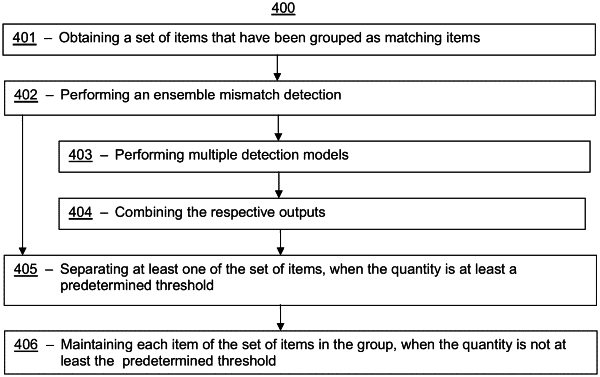| CPC G06N 3/045 (2023.01) [G06N 3/043 (2023.01); G06Q 30/0633 (2013.01); G06N 3/08 (2013.01)] | 20 Claims |

|
1. A system comprising:
one or more processors; and
one or more non-transitory computer-readable media storing computing instructions that, when executed on the one or more processors, cause the one or more processors to perform:
training an ensemble learning model using training input data for a set of training items, wherein the ensemble learning model comprises multiple detection models, and wherein respective training outputs obtained for each of the multiple detection models are combined to generate a predictive indication of a mismatch based on the ensemble learning model;
obtaining a set of items that have been grouped together as matching items in a group, wherein the items in the group comprise the set of items;
performing an ensemble mismatch detection, wherein multiple respective instances of the ensemble mismatch detection are further performed simultaneously with each other, and wherein performing the ensemble mismatch detection further comprises:
performing multiple detection models on the set of items to generate respective outputs regarding mismatches, wherein the items in the group comprise the set of items, and wherein the respective outputs comprise one or more mismatch indications;
combining the respective outputs of each multiple detection model of the multiple detection models; and
determining, by an ensemble learning model, a final mismatch decision for an item of the set of items, wherein the one or more mismatch indications collectively create the final mismatch decision, and wherein the final mismatch decision is based on whether a quantity of detected mismatches is at least a predetermined threshold of a number of mismatch indications for the item of the set of items and the respective outputs of each multiple detection model;
when the quantity of detected mismatches is at least the predetermined threshold, separating at least one of the set of items from the group; and
when the quantity of detected mismatches is not at least the predetermined threshold, maintaining each item of the set of items in the group.
|